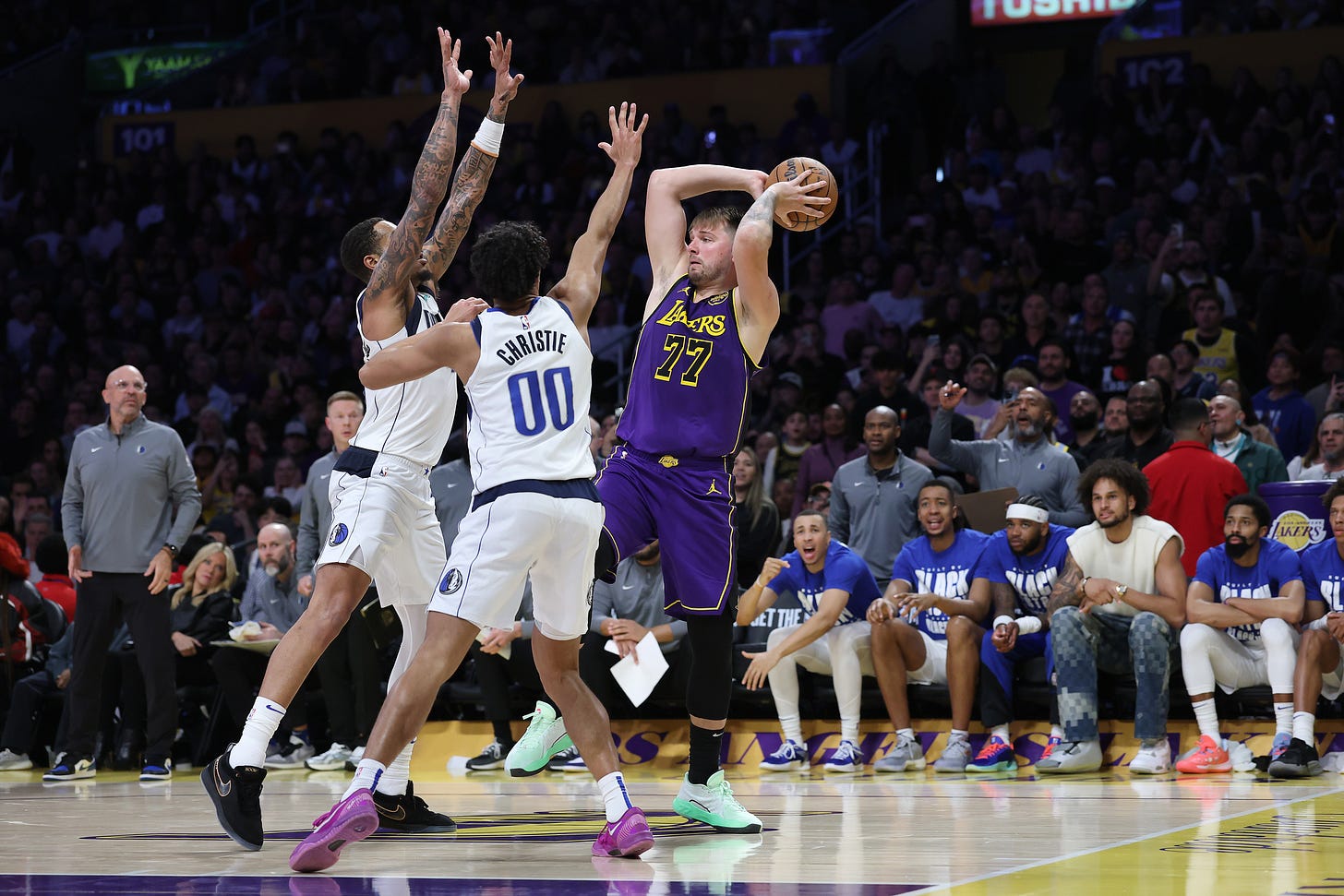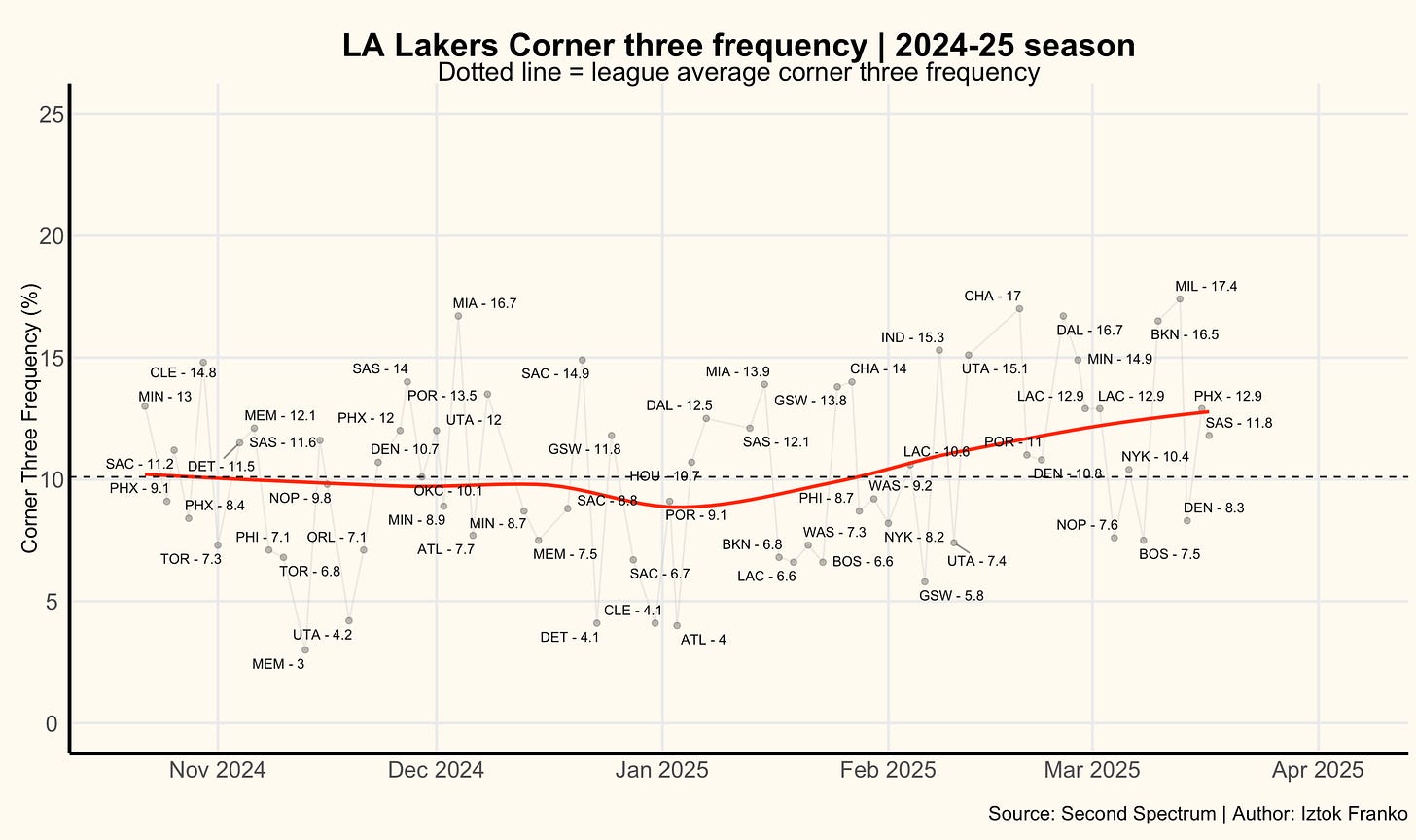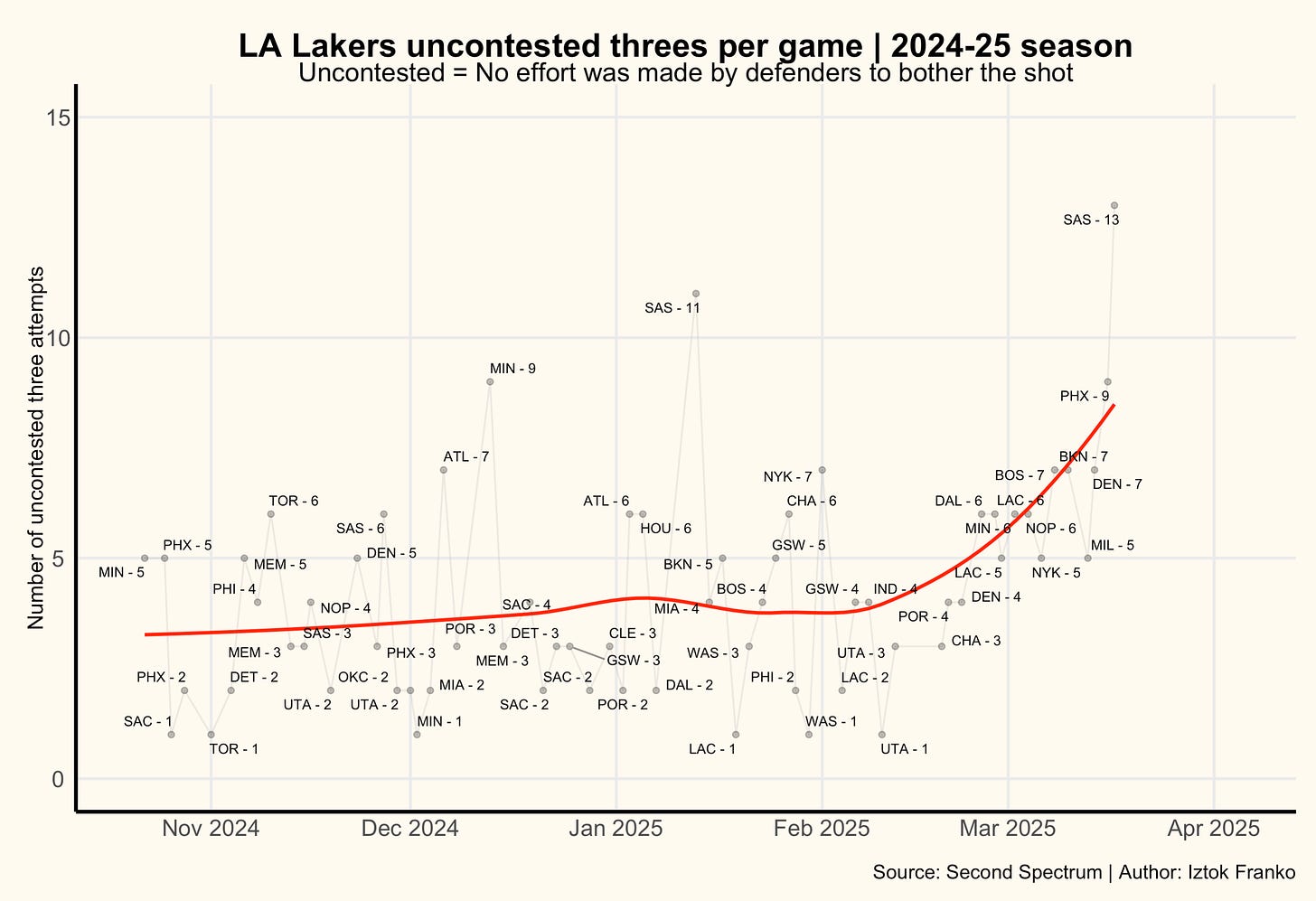The Luka Effect: The Inevitable Transformation of the Lakers' Offense
Dončić, Reaves, and the Lakers are having fun playing 4-on-3 basketball
The Luka Dončić-Anthony Davis trade, which forever linked the Mavericks and Lakers, has been pretty one-sided so far. Dončić, returning from injury, is slowly looking more like his former self and thriving in Los Angeles, while Davis—after an incredible start—went down in his first game as a Maverick and hasn’t played since.
That’s why my writing has been so Luka and Lakers centric lately. But if Davis makes his return in the next few days, as my friend Marc Stein reported he’s eager to do, I’ll dive deeper into that because it would finally be the first positive thing to happen for the Mavericks in a long while.
As for Dončić and the Lakers, they looked every bit like a contender during their eight-game winning streak, climbing to the second spot in the Western Conference. But injuries quickly derailed their momentum, with key starters and rotation players like Austin Reaves, Rui Hachimura, Jaxson Hayes, and of course LeBron James sidelined. Undermanned, they hit a mini-crisis and lost four straight games.
However, LeBron’s absence may have been a blessing in disguise, not only because it gives the 40-year-old a much-needed break before the season finale, but also because it meant Dončić and Reaves had to step up, shoulder more responsibility, and, most importantly, develop chemistry. Over the last couple of games, they’ve done exactly that and had fun doing it.
The inevitable Luka effect
For better or worse, like it or not, adding such a dominant ball-handler as Dončić to the Lakers' offense meant that the transformation into a Luka-centric offense was bound to happen. James embraced the change from the start, pushing Dončić to be himself and not fit in.
Regardless, Dončić needed a couple of games to find his legs, rhythm, and chemistry with his new teammates. However, Redick and James made a dedicated effort to put the ball in Dončić's hands more with each game, and with him as the head of the snake, the Lakers not suprisingly transformed into a pick-and-roll-heavy offense. They ranked 22nd in the NBA in pick frequency before his first game as a Laker on February 10th and have climbed to 5th since. The game, and his performance in a statement win against the Denver Nuggets, felt like a key milestone. After that, we’ve seen several trademark Dončić performances—games where he’s orchestrating the offense and manipulating every coverage opposing coaches throw at him.
There are still hiccups, like the first three and a half quarters in the marquee matchup against the Celtics and the disappointing loss in Brooklyn. Questions about Dončić’s conditioning and physical state remain, and his shot continues to look off too often. He’s shooting well below his standard in Dallas as a Laker, a reminder that he’s still working his way back to peak form. Dončić, in almost every interview, emphasizes that each day he feels better, more comfortable, and closer to the level of play he and others expect from him. And even if he’s not there yet, the best indicator that he’s getting very close is how opposing defenses treat him.
Ever since that game in Denver, Dončić has been treated—more specifically, blitzed and doubled—like the NBA’s best scorer he was last season by every team not named the Boston Celtics.
Luka, Hayes, Reaves, and the rest building chemistry while having fun playing 4-on-3 basketball
One of the key elements to maximizing and unlocking Dončić's pick-and-roll game is having an athletic big man—a lob threat who provides vertical spacing and forces opponents into aggressive tags on the roll. This allows Dončić to create an advantage either for himself by putting defenders on his hip during drives or for others, often leading to a quality corner three look.
Since that game in Denver on February 22nd, the Lakers have led the NBA in corner three frequency, with 13.7 percent of their shots coming from the corners. Before that, they ranked 24th. For reference, last year’s Mavericks, with Dončić at peak form, set an NBA record with a 12.9 percent corner three frequency.
Like Dereck Lively II and Daniel Gafford before him, Jaxson Hayes has been an instrumental part of the symbiotic relationship with Dončić. Hayes is shooting 78 percent from the floor, mostly throwing down lob dunks with Dončić on the court—an 8 percent increase in efficiency compared to when Dončić is off the floor. Lineups featuring Dončić and Hayes have a +17.4 point differential over 472 possessions so far and rank as elite on both ends of the floor according to advanced metrics. It's no coincidence that the Lakers struggled to score and lost all four games on their recent road trip while Hayes was out with a right knee contusion.
With Hayes providing Dončić a reliable lob outlet, even when teams start in more conservative coverages like drop, they typically end up resorting to more drastic measures sooner or later. And this is a move Dončić anticipates—and enjoys.
‘People start learning that at some point in game they’re going to double team me. I accept that, I like playing that, it saves my energy. And we just get to play 4 on 3.’ - Luka Dončić
Reaves as the secondary ball-handler, shooter, and blender amplifier
With James out, Reaves had to step up and find his rhythm and chemistry by playing as the secondary ball-handler next to Dončić. It's not an easy role to play, as it requires the player to morph between spot-up shooter, secondary driver, and primary playmaker roles while Dončić takes a breather. Like Jalen Brunson, Spencer Dinwiddie, and Kyrie Irving before him, Reaves seems to have the right combination of skills and attitude needed to thrive in it.
Since James' injury in Boston, Reaves has been averaging 28 points per game on 40 percent three-point shooting in the second high-usage player role. And like Dončić, he seems to be having fun playing 4-on-3 basketball.
‘We continue to build chemistry and you can tell by the way we’ve been playing. Everybody is sharing the ball. Luka obviously creates so much havoc for teams’ defense that majority of the time you’ve got to blitz him, and then you’re playing 4 on 3. It’s just a fun brand of basketball.’ - Austin Reaves
After the win against the San Antonio Spurs, J.J. Redick explained why Reaves is so valuable as the release valve for Dončić in the 4-on-3 setup, highlighting his ability to either shoot or maintain the advantage by driving against a rotating defense.
‘Having Austin as the next passer a lot of times, when there were two on the ball, or double, or they were in heavy shift from the nail…having AR there as the guy who can either shoot or create the blender with his thrust on his drives was really good.’ - J.J. Redick
Dončić and Reaves have pressed the "on" button on the blender Redick mentioned a lot recently. While it’s true that their recent opponents, the Spurs and the Suns, are struggling defensive units, to put it mildly, the trend of uncontested threes the Lakers' offense is generating is a good sign of their growing chemistry and comfort.
Despite some losses, this recent stretch without James has been an important learning and building block for Dončić, Reaves, and Redick moving forward. When James returns, he’ll add another elite, if not the ultimate, option to punish advantages in the blender, with his downhill driving ability and the improved spot-up shooting he has developed in the later stage of his career. More importantly, his presence gives Redick three capable playmakers to stagger throughout games, ensuring that at least two are on the floor at all times—an advantage few, if any, NBA teams can match.
If Dončić’s shooting remains inconsistent, teams will likely adjust by switching more, forcing him to beat them as a scorer rather than a passer or 4-on-3 initiator. Throughout his career in Dallas, we’ve seen defensive coverages against him cycle between different strategies, and that trend will continue.
But at some point in the playoffs, especially with LeBron on the bench, teams will resort to blitzing and trapping him again. When that happens, the experience gained during this stretch could prove to be a crucial factor in how the Lakers respond.









Great article, not to rehash a very frustrating February, but what Luka does offensively is absolutely irreplaceable, and went unappreciated in Dallas.